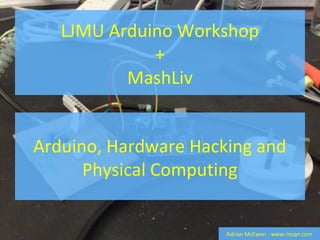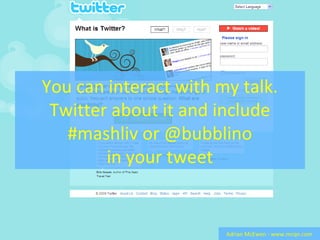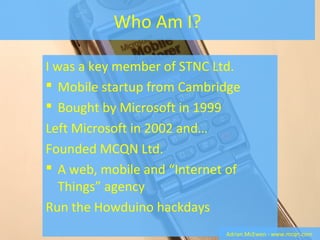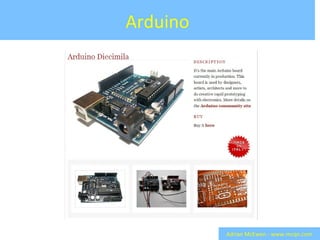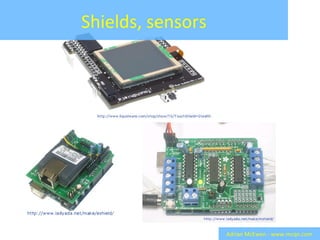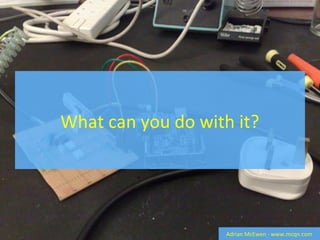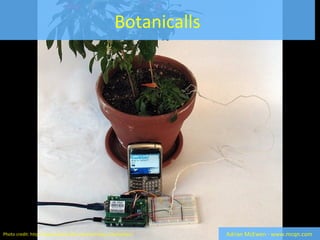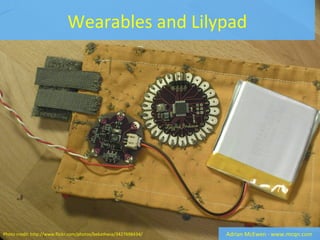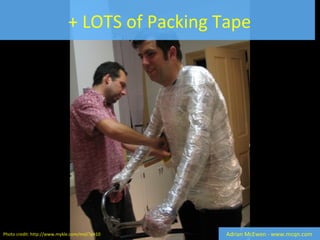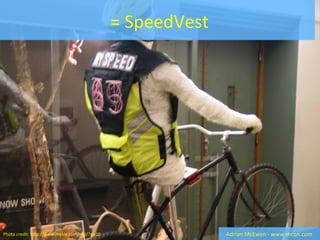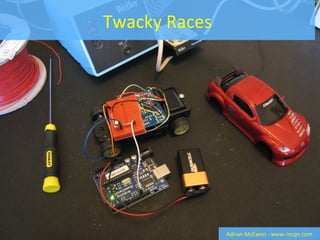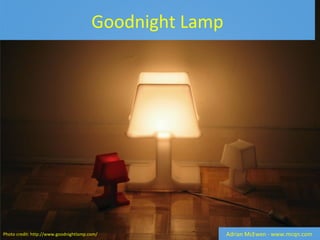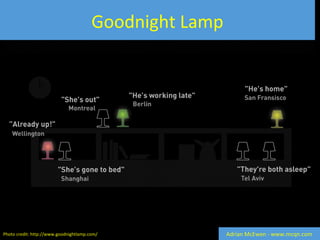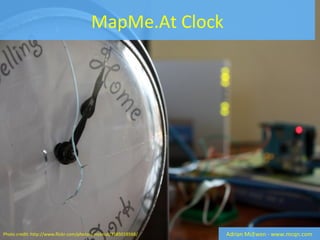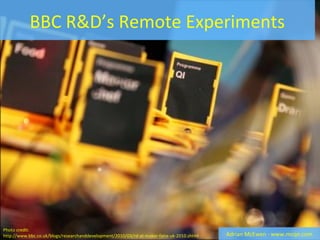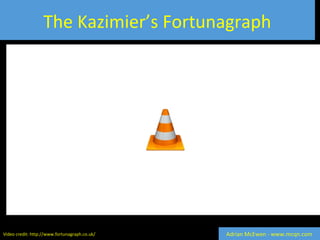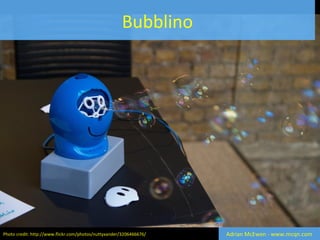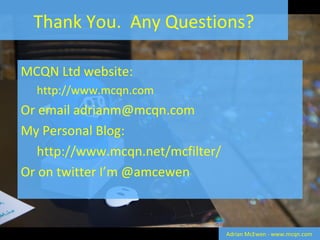Arduino, Hardware Hacking and Physical Computing - Some Examples
- 1. LJMU Arduino Workshop + MashLiv Adrian McEwen - www.mcqn.com Arduino, Hardware Hacking and Physical Computing
- 2. You can interact with my talk. Twitter about it and include #mashliv or @bubblino in your tweet Adrian McEwen - www.mcqn.com
- 3. Who Am I? I was a key member of STNC Ltd.  Mobile startup from Cambridge  Bought by Microsoft in 1999 Left Microsoft in 2002 and… Founded MCQN Ltd.  A web, mobile and “Internet of Things” agency Run the Howduino hackdays Adrian McEwen - www.mcqn.com
- 4. Arduino Adrian McEwen - www.mcqn.com
- 5. Shields, sensors Adrian McEwen - www.mcqn.com
- 6. What can you do with it? Adrian McEwen - www.mcqn.com
- 7. Tinker’s Centograph Adrian McEwen - www.mcqn.comVideo credit: http://tinkerlondon.com/what-we-do/centograph
- 8. Botanicalls Adrian McEwen - www.mcqn.comPhoto credit: http://www.botanicalls.com/archived_kits/twitter/
- 9. Wearables and Lilypad Adrian McEwen - www.mcqn.comPhoto credit: http://www.flickr.com/photos/bekathwia/3427698434/
- 10. Arduino + Electro-luminescent Wire Adrian McEwen - www.mcqn.comPhoto credit: http://www.mykle.com/msl/?p=10
- 11. + LOTS of Packing Tape Adrian McEwen - www.mcqn.comPhoto credit: http://www.mykle.com/msl/?p=10
- 12. = SpeedVest Adrian McEwen - www.mcqn.comPhoto credit: http://www.mykle.com/msl/?p=10
- 13. Twacky Races Adrian McEwen - www.mcqn.com
- 14. Goodnight Lamp Adrian McEwen - www.mcqn.comPhoto credit: http://www.goodnightlamp.com/
- 15. Goodnight Lamp Adrian McEwen - www.mcqn.comPhoto credit: http://www.goodnightlamp.com/
- 16. MapMe.At Clock Adrian McEwen - www.mcqn.comPhoto credit: http://www.flickr.com/photos/ mcknut/3585018568/
- 17. BBC R&D’s Remote Experiments Adrian McEwen - www.mcqn.com Photo credit: http://www.bbc.co.uk/blogs/researchanddevelopment/2010/03/rd-at-maker-faire-uk-2010.shtml
- 18. The Kazimier’s Fortunagraph Adrian McEwen - www.mcqn.comVideo credit: http://www.fortunagraph.co.uk/
- 19. Bubblino Adrian McEwen - www.mcqn.comPhoto credit: http://www.flickr.com/photos/nuttyxander/3206466676/
- 20. Thank You. Any Questions? MCQN Ltd website: http://www.mcqn.com Or email adrianm@mcqn.com My Personal Blog: http://www.mcqn.net/mcfilter/ Or on twitter I’m @amcewen Adrian McEwen - www.mcqn.com
Editor's Notes
- First off, a brief bio so you know a bit about who I am, and how I got here. After graduating I moved down to Cambridge to join a small startup called STNC. You won’t have heard of it, but we were doing interesting things with mobile phones and the web before most people had a mobile phone. We built the first ever web browser to run on a mobile phone. We were then bought by Microsoft when they started getting serious about phones, and after a few years working for the “Evil Empire” I left to start my own company. Since then I’ve been using my experience in writing software for very constrained platforms and knowledge of web technologies to work on projects that cut across web and mobile. More and more, I’ve been interested in, and helping people with, the emerging “Internet of Things” – getting data out of the real world and into the Internet; or out of the Internet and into the real world
- The Arduino boards are at the vanguard of this experimentation and movement into physical computing and the “Internet of Things”. It’s an open-source hardware and software project to provide an easy way into connecting motors, lights, switches, all sorts of things in the real world to the digital one.
- It’s really easy to extend the capabilities of your Arduino board just by plugging in one of many “shields” – add on boards that add ethernet, or a screen, or an easy way to hook up motors, or...
- This project was done by Tinker London, when they worked with the students of St. Paul’s School to produce a machine to let you visualize google search results in a physical bar chart. See http://tinkerlondon.com/what-we-do/centograph for full details
- Botanicalls is a plant for the geek who doesn’t have green fingers. Two probes in the soil let the Arduino check how moist the soil is, and the plant then tweets when it needs to be watered or sends tweets of thanks when you remember to water it. http://www.botanicalls.com/archived_kits/twitter/
- The Lilypad is a specialized Arduino board which is designed to be used easily in wearable computing projects. It makes it easy to sew conductive thread to makes the connections to the board and wire up circuits to LEDs, accelerometers or strain sensors... Visit http://www.fashioningtech.com/ to find out lots more about people playing with the intersection of fashion and computing.
- Electro-luminescent wire is flexible wire that lights up when you pass a high-frequency electric current through it. These guys overlaid lots of different pieces of EL wire, each in the shape of a different number onto the back of a jacket…
- They also used a low-tech packing tape and cling-film solution to build a mannequin to show off their project in the final year show
- And when it’s all put together – the vest picks up the speed of the bike from a bike computer and displays it on the EL wire, so surrounding travellers have more visibility of the cyclist and how fast they are travelling. See http://speedvest.com/ for more details
- Twacky Races was a project I did for FACT’s Art of Digital conference last year. Each attendee had an RFID tag on their conference badge and they were split into teams. They worked out which team they were on, and unlocked scavenger hunt clues by swiping their badge over an RFID reader connected to a computer. Then when they found the scavenger hunt locations they swiped their tag to unlock the part from that location – swiping their tag at an old record player caused the turntable to rotate and give them an Arduino; an old PC case had been turned into a vending machine with spiral dispensing mechanism to give some wires, LEDs, and battery; and another old record deck had been turned into a number of locked compartments which revealed a radio-controlled car chassis. At the end of the day each team built a hacked radio-controlled car which then drag-raced based on how much the teams had been tweeting.
- This is a project from Alex who runs Tinker London. You buy the lamp and “baby” lamps as a set, and then give the small ones to friends and loved ones who live far away. The little lamps copy the state of the big lamp, so when you turn your lamp on, the ones you’ve given out turn on too...
- ...this lets your loved ones have a background awareness of the cycles and rhythms of your life, even though you’re apart. And if you have small lamps of theirs then you get to find out a bit more about what they’re up to. http://www.goodnightlamp.com/
- John McKerrell, founder of local (Liverpool) startup MapMe.At built this clock. MapMe.At provides ways for people to track their location, so John added an Arduino, ethernet shield and stepper motor to this old clock so it can then query the MapMe.At website to find out where he and his wife are. It then shows their location – Home, Work, Travelling, etc. – on the clock so that whoever is home can see where the other is. http://blog.johnmckerrell.com/2009/06/01/hacking-location-into-hardware/
- The BBC R&D team spent some time with Tinker London recently to use the Arduino as a platform for prototyping and experimentation into remote controls. This particular example uses the old Guess Who game board, but rather than people’s faces, the cards show genres of TV programmes or programmes themselves. The aim is to help groups of people, such as a family, to collaboratively decide what to watch. Each person takes it in turn to choose a criteria – “no sports programmes” for example – and when that card is knocked down the system will illuminate little LEDs next to the other cards that match that criteria and should also be closed. When one programme remains, the system searches iPlayer and queues up the latest available episode of that show to be watched. See http://www.bbc.co.uk/blogs/researchanddevelopment/2010/03/a-touch-less-remote-part-1-of.shtml for all the details of their prototyping
- Liverpool-based art collective the Kazimier produce some amazing events – part theatre, part gig, part club, and often use Arduinos to provide additional interactivity and more amazing installations. This is a piece from a recent event. When attendees entered the room containing the Spinning Fortunagraph they were met by one of the Kazimier who told them the tale of how he’d inherited this amazing machine. He wasn’t quite sure how it all worked, but if they chose a tarot card and placed it in this slot then he could tell their fortune. It’s a beautifully made machine and the technology that makes it come alive is completely hidden away. The tarot card contains an RFID tag so that the different ones can be recognised, and then a rotary encoder connected to an Arduino works out the speed that the machine is spinning and communicates with a PC running the projector so that the graphics on top can be matched to the movement. See the video at http://www.fortunagraph.co.uk/
- Bubblino, the twitter-watching, bubble-blowing Arduino bot who seems to upstage me wherever I go :-) http://www.mcqn.com/bubblino

